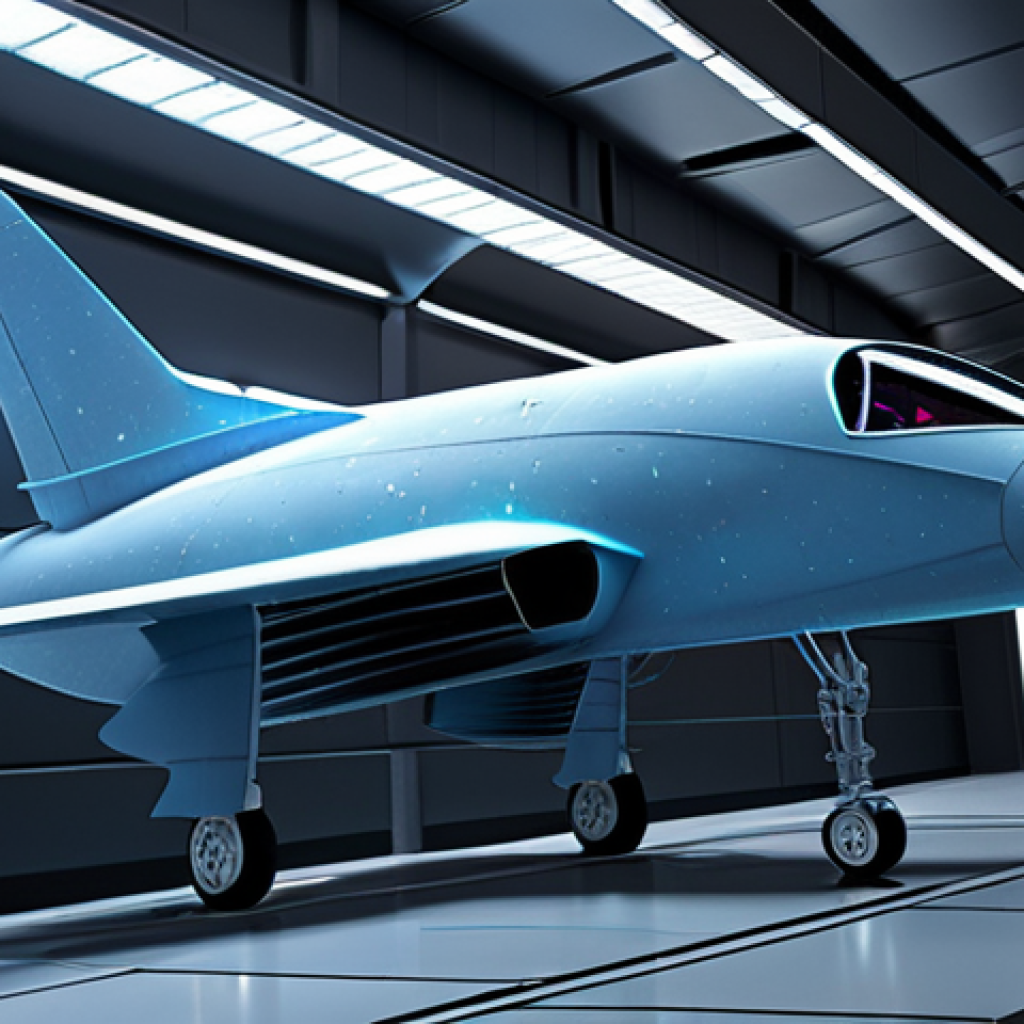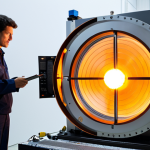Designing an aircraft was once an immensely laborious process, often involving countless hours in physical wind tunnels, making iterative changes that felt glacially slow.
But let me tell you, stepping into the world of Computational Fluid Dynamics (CFD) has been nothing short of a revolution. I’ve personally witnessed how this digital alchemy transforms the design cycle, allowing engineers to simulate complex airflow with a precision and speed that was unimaginable just a decade ago, saving immense time and resources.
As we look to the future, tackling challenges like sustainable aviation and the rise of urban air mobility, CFD isn’t just an optimization tool; it’s the very foundation upon which these next-gen aircraft are being conceived and refined, predicting performance with mind-boggling accuracy before a single piece of metal is cut.
It’s truly thrilling to see how digital twin technology is pushing the boundaries of what’s aerodynamically possible, addressing critical issues like drag reduction and lift enhancement.
Let’s dive deeper below.
The Digital Wind Tunnel: Beyond Physical Limitations

When I first started in this field, the sheer bottleneck of physical wind tunnels was a constant source of frustration. Imagine building a prototype, testing it, finding a tiny flaw, and then having to completely re-fabricate a new model just to test that single tweak.
It was painstakingly slow, incredibly expensive, and frankly, a bit soul-crushing when you knew the answer was just a small adjustment away. What CFD did, almost overnight, was eliminate that physical barrier.
Suddenly, we could run hundreds, even thousands, of simulations in a fraction of the time it took for one physical test. I remember feeling a sense of immense liberation, like a creative floodgate had just burst open.
This wasn’t just about speed; it was about the freedom to innovate, to try wild ideas that would have been financially ruinous in the physical world. The precision of these digital simulations, leveraging complex algorithms to mimic real-world airflow, truly blew me away.
We could zoom in on tiny vortices, observe pressure differentials at microscopic levels, and understand phenomena that were previously just theoretical approximations.
It felt like we’d finally acquired x-ray vision for airflow, transforming design from a trial-and-error gamble into a data-driven, highly optimized science.
This shift has not only accelerated design cycles but also allowed for the exploration of truly revolutionary aircraft concepts.
1. Unveiling the Micro-Dynamics of Airflow
One of the most profound benefits I’ve observed from CFD is its unparalleled ability to zoom into the intricate dance of air around an aircraft. In a physical wind tunnel, you might get a general understanding of lift and drag, perhaps some smoke visualization, but detailed flow separation or reattachment phenomena at specific points could remain elusive.
With CFD, we can dissect the flow field into millions of tiny cells, calculating pressure, velocity, and turbulence for each one. This granular detail is a game-changer.
For instance, I recall working on a wing design where a specific wingtip device was causing unexpected drag. Through CFD, we were able to visualize the exact vortex shedding pattern, pinpointing where the energy was being lost.
This level of insight allowed us to redesign that tiny component with incredible precision, leading to a significant drag reduction that would have taken months, if not years, to achieve with traditional methods.
It’s like having an infinitely adjustable microscope for aerodynamics, allowing engineers to not just see what’s happening, but truly understand *why* it’s happening.
2. The Cost-Benefit Revolution of Digital Prototyping
Beyond just speed and precision, the financial implications of embracing CFD have been monumental for the aerospace industry, and for smaller companies like some I’ve consulted with, it’s been nothing short of a lifesaver.
The sheer cost of building and testing physical prototypes is astronomical. Materials, labor, facility rental – it all adds up incredibly quickly. When you can iterate on a design entirely in a virtual environment, the savings are staggering.
I’ve seen projects where the initial CFD investment paid for itself tenfold within the first few months, simply by eliminating a single physical build cycle that would have required tens of thousands, if not hundreds of thousands, of dollars.
This democratizes innovation, allowing smaller teams with brilliant ideas to compete with established giants, something that was almost unthinkable in the pre-CFD era.
It’s not just about reducing expenses; it’s about reallocating those resources into further research, more advanced materials, and ultimately, safer and more efficient aircraft.
Unlocking Aerodynamic Secrets: Precision at Your Fingertips
The true magic of CFD, in my humble opinion, lies in its capacity to peer into aerodynamic mysteries with an almost eerie level of accuracy. It’s one thing to calculate a theoretical coefficient of lift; it’s another entirely to visualize the pressure distribution across an entire airframe, identifying localized high-pressure zones that could lead to structural stress or low-pressure areas that indicate undesirable flow separation.
This predictive power is what truly sets it apart. Before CFD became mainstream, we relied heavily on empirical data, simplified models, and gut feelings, which, while valuable, could never capture the full complexity of turbulent flow.
Now, with sophisticated algorithms and immense computational power, we can simulate scenarios like transonic flight, high-angle-of-attack stalls, and even the interaction between multiple aircraft components with stunning fidelity.
I’ve personally used these tools to fine-tune wing profiles, optimize engine nacelle designs, and even strategize the optimal placement of antennas – details that collectively contribute to significant performance gains.
It’s like having a crystal ball that shows you exactly how your design will behave in the air, long before it ever leaves the ground.
1. From Hypothesis to Visualization: The Iterative Design Cycle
The iterative design cycle has been fundamentally transformed by CFD. What used to be a linear, sequential process – design, build, test, redesign – has become a rapid, parallel process where design concepts can be validated and refined in near real-time.
My team and I once worked on a new winglet concept for a regional jet. We started with an initial design, ran it through CFD, immediately identified areas of high induced drag, adjusted the geometry digitally, and re-ran the simulation.
This cycle of analysis-refinement-reanalysis could be repeated dozens of times in a single day. Each iteration brought us closer to the optimal design, all without touching a single piece of aluminum.
It felt incredibly efficient, almost like sculpting with air. This agility means that we can explore a much broader design space, allowing for truly novel solutions that might never have been considered due to the prohibitive costs and time constraints of physical testing.
It’s a designer’s dream come true, turning abstract ideas into tangible aerodynamic performance data at an unprecedented pace.
2. The Art of Drag Reduction and Lift Enhancement
Achieving optimal drag reduction and lift enhancement is the holy grail of aircraft design, and CFD is our most potent weapon in this pursuit. Every percentage point of drag reduction translates directly into fuel savings, extended range, and reduced emissions, which is critical in today’s environmentally conscious world.
Similarly, maximizing lift efficiency allows for shorter take-off distances, higher payloads, and improved maneuverability. Through CFD, we can meticulously analyze the boundary layer, the thin layer of air directly adjacent to the aircraft’s surface, where much of the drag is generated.
By understanding its behavior, we can implement strategies like laminar flow control, optimize surface smoothness, or design subtle curvatures that minimize separation.
I remember vividly a project focused on optimizing the fairing between the wing and fuselage. Using CFD, we identified a small area of flow separation that, once smoothed out digitally, resulted in a measurable reduction in overall drag.
It’s these kinds of granular insights that make the biggest difference in the real world, translating into significant operational cost savings for airlines and improved flight characteristics for pilots.
Real-World Impact: How CFD Reshapes Aircraft Development
The tangible impact of CFD on modern aircraft development is impossible to overstate. It’s not just an academic exercise; it’s a critical, indispensable tool that influences every major decision, from the initial conceptual sketches to the final certification tests.
Think about any modern commercial airliner, military jet, or even the burgeoning eVTOLs for urban air mobility – their aerodynamic profiles have been meticulously sculpted and verified through thousands of hours of CFD simulations.
This translates directly into safer, more fuel-efficient, and quieter aircraft. I’ve seen how CFD has been instrumental in optimizing engine intakes, designing quieter landing gear, and even predicting the icing potential on wings in various atmospheric conditions.
The confidence it instills in designers and engineers is immense. When you can tell a certification authority that your design has been virtually tested under a myriad of flight conditions, with data to back it up, it significantly streamlines the approval process.
It’s about building a robust, data-driven case for every design choice, minimizing risks and maximizing performance right from the digital drawing board.
1. Validating Performance Before Take-off
Before a new aircraft prototype ever rolls out of the hangar, CFD has already put it through its paces in countless virtual flights. This validation phase is critical for identifying potential issues that could be catastrophic in actual flight.
We can simulate extreme maneuvers, gust loads, crosswinds, and even bird strikes, analyzing the aerodynamic response and structural integrity. I’ve personally been involved in projects where CFD simulations revealed unforeseen aerodynamic instabilities at high Mach numbers, allowing engineers to modify the control surfaces and redistribute mass before any metal was cut.
This proactive problem-solving capability is invaluable. It’s not about replacing flight tests entirely, but rather about making those incredibly expensive and time-consuming physical tests as efficient and safe as possible, ensuring that when the aircraft finally takes to the skies, its fundamental aerodynamic characteristics are already well understood and optimized.
2. CFD’s Role in Certification and Safety
The aerospace industry is, quite rightly, one of the most heavily regulated sectors globally, with safety as the paramount concern. CFD has emerged as a powerful tool not just for design, but also for supporting the rigorous certification process.
Regulatory bodies increasingly accept CFD data as part of the evidence package for new aircraft designs, provided the simulations are validated against experimental data.
This doesn’t mean you can skip all physical tests, but it does mean you can significantly reduce their scope and cost by using CFD to fill in the gaps and provide a deeper understanding of the aircraft’s behavior.
For instance, I’ve seen CFD used to demonstrate compliance with specific stability and control requirements, or to predict aerodynamic loads on critical components under various failure scenarios.
This ability to rigorously document and virtually test ensures that every aircraft reaching the market has undergone an unprecedented level of scrutiny, bolstering trust and ultimately making air travel even safer.
Driving Innovation: CFD’s Role in Sustainable Aviation
The urgency to decarbonize aviation is undeniable, and from my vantage point, CFD is at the forefront of this green revolution. When you talk about electric propulsion, hydrogen power, or even radical new airframe designs for future urban air mobility vehicles, the aerodynamic challenges are immense and often entirely novel.
Traditional design methods simply wouldn’t cut it. CFD allows engineers to rapidly prototype and test these revolutionary concepts in the digital realm, iterating on designs that reduce drag, improve lift-to-drag ratios, and minimize noise, all critical factors for sustainable and community-friendly aircraft.
I’m incredibly excited by the possibilities here; seeing companies design aircraft with incredibly efficient wing designs or integrated propulsion systems that simply wouldn’t be feasible without detailed CFD analysis.
This isn’t just about making existing designs incrementally better; it’s about fundamentally rethinking how aircraft fly, and CFD is the essential enabler for that paradigm shift.
1. Crafting the Future: eVTOLs and Electric Aircraft
The rise of electric vertical take-off and landing (eVTOL) aircraft and other electric-powered concepts presents a fascinating new frontier for CFD. These aircraft often feature distributed propulsion systems, novel wing configurations, and operate at much lower altitudes and airspeeds than traditional planes, leading to unique aerodynamic challenges.
How does the wake of one propeller interact with another? What’s the optimal tilt angle for transition from vertical to horizontal flight? CFD is the primary tool being used to answer these complex questions.
I’ve witnessed teams simulate entire flight profiles of eVTOLs, from vertical ascent through transition and cruise, meticulously analyzing the airflow around multiple rotors and wings.
This level of detail is indispensable for ensuring the stability, efficiency, and quiet operation of these futuristic vehicles. It’s truly thrilling to see digital twin technology helping to birth an entirely new category of air transportation right before our eyes.
2. The Quest for Ultra-Efficient Aerodynamics
Beyond novel aircraft concepts, CFD is relentlessly pushing the boundaries of aerodynamic efficiency in conventional aircraft as well. Every tiny improvement in lift-to-drag ratio contributes significantly to reducing fuel consumption and emissions.
This involves highly specialized areas like laminar flow control where CFD helps design surfaces that maintain smooth, undisturbed airflow for longer, significantly cutting down on frictional drag.
Or consider the meticulous optimization of wing-body fairings, engine nacelles, and even landing gear doors to minimize their aerodynamic resistance. It’s a never-ending quest for perfection, and CFD provides the detailed insights needed to squeeze every last drop of efficiency out of a design.
My personal involvement in these projects has shown me how even seemingly minor adjustments, when confirmed by precise CFD data, can lead to substantial real-world gains in fuel economy, which translates directly to airline operational costs and, ultimately, environmental benefits.
The Human Element: My Journey with CFD Tools
Working with CFD has been an incredibly rewarding part of my career, truly shaping my perspective on engineering design. It’s not just about running software; it’s about understanding the underlying physics, interpreting the complex visualizations, and using that insight to make critical design decisions.
I remember feeling overwhelmed by the sheer volume of data in my early days, but with experience, you start to see patterns, to intuitively grasp how different geometries affect airflow.
It’s a skill that combines technical expertise with a touch of artistry. There’s a profound satisfaction that comes from identifying a problematic flow feature in a simulation, devising a subtle geometric change, and then seeing the CFD results confirm your hypothesis – a perfect laminar flow where there was once turbulence.
It’s a powerful feeling of discovery and problem-solving, and it’s why so many engineers, myself included, are so passionate about these tools.
1. Navigating the Nuances of Simulation Setup
While CFD offers incredible power, getting accurate results is far from a click-of-a-button exercise. The quality of your output hinges entirely on the quality of your input and setup.
I’ve learned through trial and error (and a fair bit of head-scratching!) that meshing, which is dividing the physical domain into discrete cells, is an art form in itself.
Too coarse, and you miss critical details; too fine, and your simulation takes forever. Then there’s selecting the right turbulence model, setting appropriate boundary conditions, and ensuring convergence.
It’s a meticulous process that requires patience and a deep understanding of fluid dynamics. I’ve seen projects go awry because of a seemingly minor error in the setup, leading to inaccurate results that could mislead an entire design team.
My experience has taught me to always double-check, to validate assumptions, and to approach every simulation with a healthy dose of skepticism until the results are rigorously verified.
2. Interpreting the Data: From Numbers to Insights
The real value of a CFD simulation doesn’t come from the colorful images it generates, but from the insights you extract from the vast amounts of numerical data.
It’s one thing to see a pressure contour map, it’s another to understand *why* those pressure patterns exist and *what* they mean for performance. This is where the human element truly shines.
I’ve spent countless hours sifting through velocity vectors, turbulence kinetic energy plots, and wall shear stress distributions, looking for the subtle clues that explain an aircraft’s aerodynamic behavior.
It’s a bit like being a detective, piecing together fragments of information to form a complete picture. This process often involves comparing different simulation runs, cross-referencing with analytical models, and sometimes even looking at historical physical test data.
The ability to translate complex data into actionable design improvements is where an experienced CFD engineer truly adds immense value.
Overcoming Hurdles: Navigating the Complexities of CFD
While I champion CFD as a transformative technology, it’s essential to acknowledge that it’s not without its challenges. The journey to mastering CFD and leveraging its full potential is fraught with complexities, from the sheer computational demands to the nuanced art of model validation.
It’s not a magic bullet; rather, it’s a sophisticated tool that requires significant expertise and computational resources. I’ve seen many aspiring engineers get frustrated by long simulation times or results that don’t quite match their expectations.
But as I’ve learned, patience and a methodical approach are key. Understanding the limitations of the models you’re using, knowing when to simplify, and when to delve into higher fidelity simulations – these are the skills that separate a basic user from a truly effective CFD practitioner.
It’s an ongoing learning process, as the software and algorithms continue to evolve at a rapid pace.
1. Computational Demands and Hardware Constraints
One of the most persistent hurdles in CFD is the sheer computational power required, especially for high-fidelity simulations. Running a complex, transient simulation of an entire aircraft can take days, even weeks, on powerful clusters.
This means significant investment in hardware – high-performance computing (HPC) clusters, powerful GPUs, and ample storage. I remember a project involving complex unsteady aerodynamics where we literally had to book time on a supercomputer to run the simulations.
For smaller companies or research groups, this can be a significant barrier to entry. While cloud computing has certainly helped democratize access to HPC resources, managing these resources efficiently and optimizing simulations for parallel processing remains a critical skill.
It’s a constant balancing act between desired accuracy and available computational budget.
2. The Ever-Present Challenge of Validation and Verification
No matter how sophisticated your CFD simulation, the results are ultimately meaningless if they haven’t been rigorously validated and verified. Validation involves comparing simulation results against real-world experimental data – whether from wind tunnels or flight tests.
Verification, on the other hand, ensures that the numerical model is correctly solving the underlying equations. This process is painstaking and crucial for building trust in the simulation results.
I’ve personally spent countless hours pouring over data from both simulations and physical tests, looking for discrepancies, understanding sources of error, and refining models until the correlation is strong.
It’s a continuous loop of refinement and cross-checking, ensuring that the digital predictions accurately reflect physical reality. This critical step ensures that the insights gained from CFD are reliable and truly actionable for aircraft design.
| Feature | Traditional Wind Tunnel Testing | Computational Fluid Dynamics (CFD) |
|---|---|---|
| Cost Per Iteration | High (model fabrication, facility rental) | Low (software licenses, computing resources) |
| Time Per Iteration | Weeks to Months | Hours to Days |
| Level of Detail | Surface pressures, flow visualization (macro) | Volumetric flow fields, microscopic details (micro) |
| Flexibility in Design Change | Limited (physical modification needed) | High (digital geometry modification) |
| Scenario Simulation | Specific conditions (limited environmental control) | Wide range (virtual conditions, extreme scenarios) |
The Future is Fluid: Where CFD Takes Us Next
Looking ahead, the evolution of CFD in aircraft design is incredibly exciting. We’re already seeing the integration of CFD with machine learning and artificial intelligence, leading to even faster and more accurate predictive capabilities.
Imagine AI-driven optimization algorithms that automatically suggest design changes based on CFD results, pushing the boundaries of what’s aerodynamically possible even further.
There’s also the increasing push towards multi-physics simulations, where CFD is coupled with structural mechanics, thermal analysis, and even acoustic simulations to create a truly holistic digital twin of an aircraft.
This comprehensive approach will allow engineers to understand not just how air flows around a wing, but how that flow impacts its structural integrity, its thermal signature, and even the noise it generates.
It’s a holistic vision that promises to unlock unprecedented levels of design optimization and innovation.
1. AI & Machine Learning: The Next Frontier for Aerodynamics
The convergence of CFD with artificial intelligence and machine learning is perhaps the most exciting development on the horizon. AI algorithms can be trained on vast datasets of CFD simulation results, learning complex relationships between geometry, flow patterns, and performance metrics.
This can lead to predictive models that are orders of magnitude faster than running full CFD simulations, enabling real-time design optimization or rapid concept exploration.
I’ve already seen early research where AI agents are used to generate novel aerodynamic shapes that human engineers might never conceive, pushing the limits of efficiency.
This doesn’t mean AI replaces the engineer; rather, it empowers us with superhuman analytical capabilities, allowing us to focus on the truly creative and strategic aspects of design.
It’s an incredible partnership between human ingenuity and artificial intelligence that will redefine the future of flight.
2. Towards Comprehensive Digital Twins
The ultimate goal in aerospace design is the creation of a comprehensive “digital twin” – a virtual replica of an aircraft that behaves exactly like its physical counterpart in every single aspect.
CFD is a cornerstone of this vision, providing the detailed aerodynamic behavior. But the future involves integrating this with structural analysis (FEA), thermal management, propulsion system modeling, and even flight control system simulations.
Imagine being able to run a virtual flight from take-off to landing, experiencing every load, every thermal fluctuation, and every control input, all within the digital realm.
This level of holistic simulation will dramatically reduce the need for expensive physical prototypes and ground tests, accelerating development cycles even further and allowing for continuous optimization throughout an aircraft’s operational life.
It’s not just about designing an aircraft, it’s about designing its entire lifecycle, digitally, from cradle to grave.
Conclusion
As I reflect on the journey of aircraft design, it’s clear that Computational Fluid Dynamics has been nothing short of a revolution. It transformed a field once constrained by physical limitations and exorbitant costs into a dynamic, data-driven science. From enabling engineers to peer into the microscopic dance of airflow to accelerating the development of sustainable aviation, CFD is the bedrock of modern aerospace innovation. It’s truly an indispensable tool that continues to push the boundaries of what’s possible, allowing us to build safer, more efficient, and more environmentally friendly aircraft for the skies of tomorrow.
Useful Information to Know
1. CFD is a powerful software tool used to simulate how fluids (like air or water) flow around objects, providing detailed insights into aerodynamic performance without needing physical models.
2. It significantly reduces the time and cost associated with aircraft development by allowing engineers to test and iterate designs digitally, eliminating many expensive physical prototypes.
3. CFD enables the detailed visualization of complex phenomena such as turbulence, pressure distribution, and flow separation, which are often difficult or impossible to observe in physical tests.
4. Modern aircraft, including commercial airliners and advanced eVTOLs, are heavily reliant on CFD for their design, optimization, and certification processes, ensuring safety and efficiency.
5. The future of CFD includes integration with AI and machine learning, promising even faster simulations, autonomous design optimization, and the creation of highly accurate “digital twins” of aircraft.
Key Takeaways
Computational Fluid Dynamics (CFD) has fundamentally reshaped aerospace engineering, offering unparalleled precision, cost efficiency, and speed in aircraft design. It allows for deep understanding of airflow dynamics, rapid design iteration, and crucial support for certification and safety. As an indispensable tool, CFD is also leading the charge in sustainable aviation and the development of future aircraft concepts, continuously pushing the boundaries of aerodynamic innovation.
Frequently Asked Questions (FAQ) 📖
Q: You spoke about CFD being a ‘revolution’ and saving ‘immense time and resources.’ From your experience, how dramatic is this shift compared to the old ways, like endless hours in a physical wind tunnel?
A: Oh, it’s not just ‘some’ savings; it’s like comparing dial-up to fiber optic! I’ve been there, remember the days: you’d design a wing, build a scaled model – sometimes taking weeks – then haul it to the wind tunnel.
You’d run tests, meticulously collect data, only to find a tiny tweak was needed. Then it was back to the drawing board, waiting for another prototype, more testing.
That entire cycle could stretch for months, and each iteration was a significant chunk of change. With CFD, it’s a completely different ballgame. You can virtually ‘fly’ thousands of design variations overnight, adjusting parameters on the fly, seeing the fluid dynamics instantly.
It’s an iterative loop that now takes days, not months. The cost savings on physical prototypes and facility time alone? Staggering.
It means we can explore radically more innovative designs without breaking the bank or missing critical deadlines. It truly transforms what’s economically viable.
Q: Looking ahead, you highlighted CFD’s role in sustainable aviation and urban air mobility. Can you elaborate on how it serves as ‘the very foundation’ for these next-gen aircraft, especially given their unique challenges?
A: Absolutely. Think about sustainable aviation first – every gram of drag reduced, every ounce of lift optimized, translates directly into fuel efficiency, which means lower emissions and reduced operating costs.
CFD allows us to precisely sculpt aircraft surfaces, integrate new propulsion systems like electric motors, and optimize wing designs for very specific flight profiles, all crucial for achieving those ambitious sustainability targets.
For urban air mobility – think eVTOLs zipping between skyscrapers – the airflow isn’t just straightforward forward flight. You’ve got complex interactions with buildings, gusty conditions, and vertical take-off and landing phases where rotor downwash and vehicle body aerodynamics are incredibly tricky.
Trying to physically test every scenario? Impossible, or at least astronomically expensive. CFD lets us model these incredibly intricate, transient airflow conditions, ensuring safety, stability, and efficiency for a whole new class of aircraft that truly operate in a 3D urban environment.
It’s about predicting the unpredictable before it happens.
Q: The concept of ‘digital twin technology’ sounds fascinating. How exactly does it integrate with CFD, and what kind of ‘mind-boggling accuracy’ and ‘aerodynamic possibilities’ are we seeing with it for things like drag reduction and lift enhancement?
A: It’s genuinely thrilling, isn’t it? Imagine a high-fidelity virtual replica of an aircraft, right down to the rivet. That’s your digital twin.
CFD is a huge part of its beating heart. We feed our CFD models with real-world flight data – pressure sensors, temperature readings, even pilot feedback – and CFD then uses that input to continuously refine the aerodynamic model within the digital twin.
This isn’t just a static design; it’s a living, breathing simulation that constantly learns and evolves. This allows us to predict performance with ‘mind-boggling accuracy’ because we’re not just guessing; we’re using a model that’s been validated and continually updated by actual flight conditions.
For drag reduction, it means we can identify tiny turbulent pockets or pressure anomalies that would be invisible to traditional methods, then virtually smooth them out, sometimes gaining percentage points of efficiency that translate to millions in fuel savings over an aircraft’s lifetime.
For lift enhancement, it’s about precisely tailoring wing and control surface designs for optimal performance across various speeds and altitudes, giving pilots more control and making flights smoother.
We’re literally pushing the envelope of what’s aerodynamically achievable, all in the digital realm first.
📚 References
Wikipedia Encyclopedia
구글 검색 결과
구글 검색 결과
구글 검색 결과
구글 검색 결과
구글 검색 결과






